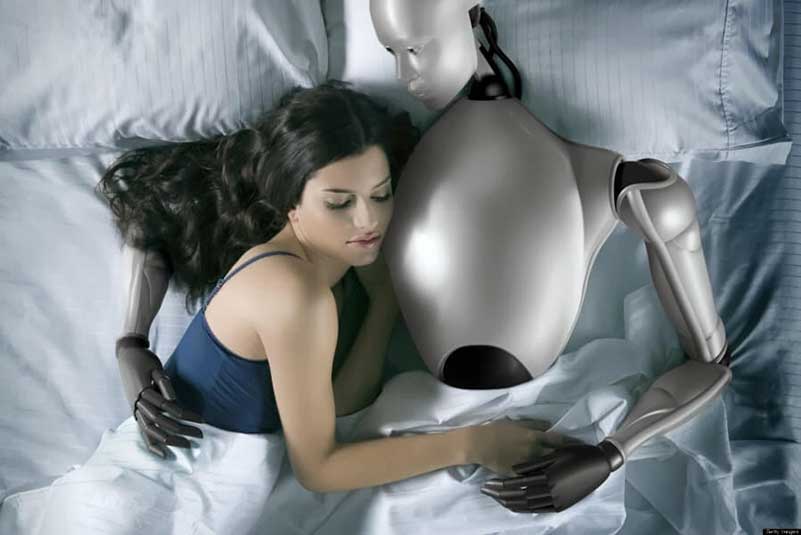- Is it a doll? Is it a device? What makes something a sex robot?
- From artificial intelligence to nanotechnology: what happens inside the sexbot?
- Avoiding the creep factor
- Predictions: will sex with robots become more common than sex with humans?
- Sexbots, yay or nay? Public opinion polls in the here and now
- Full-on sex with robots is only a matter of time
It’s an intriguing concept – sex with a robot. Quite a few filmmakers have explored this concept in Sci-Fi movies such as Ex Machina and Her. With the exponential developments in artificial intelligence and robotics, we are now closer than ever to a life in which robots will fulfil increasingly social roles. They are very likely to become our bed partners and we may even develop emotional connections with them. David Levy, author of ‘Love and sex with robots’ estimates that in 2050, marriages between robots and humans will be ‘normal’. It seems as if we are on the brink of a new sexual revolution. Love it or hate it – the sexbots are coming.
Is it a doll? Is it a device? What makes something a sex robot?
From a technical perspective, a sexbot is a device that is designed and built for sex. There are many ‘tools’ available already that facilitate sexual experiences that are more ‘tangible’ than porn and more ‘convenient’ than sex with a human partner, but these are devices, not robots. When it comes to sexbots, we’re talking humanoid shapes with built-in capabilities for sexual acts. These sex robots will be kitted out with artificial intelligence which would enable them to do more than merely react to sensors. Their algorithms will be capable of learning and can predict and initiate sexual actions or positions they think you may enjoy, based on previous experiences. They will respond to your facial expressions and look at your eyes and body language for cues.
Abyss Creations in California are a good example of what a humanoid sex robot would look like. Their RealDolls are extremely realistic and can be customised to the client’s specifications. They can even make her (or him) look like your favourite celebrity or ex-girl/boyfriend – with explicit consent of the celeb or ex-partner in question, of course. Abyss’ customers come from all walks of life and from every thinkable corner of the globe. They include scientists, artists, photographers, futurists, health professionals, singles and couples that want to spice up their sex life. While these dolls have no integrated robotics technology yet, that’s just a matter of time. The success of the RealDolls is proof that it is possible to develop emotional connections with inanimate objects and McMullen, creator of the RealDolls, wants to take this a step further. His team is currently involved in the RealBotix project, developing high end silicon dolls with customisable artificial intelligence and tactile simulation technologies, enabling users to interact with the ‘personalities’ of the dolls. Their first prototypes are still in development and they anticipate production to start in 2017. ‘Harmony’, the artificially intelligent head they’re working on attaches to any existing RealDoll body and can blink, open and close its mouth and even hold a conversation. After the AI head prototype is completed, McMullen will start developing the full AI body; his aim being to design a humanoid sexbot that behaves as if she’s enjoying it.

From artificial intelligence to nanotechnology: what happens inside the sexbot?
Up until now, roboticists have been unable to replicate natural human movement, so smooth moving humanoid sexbots are still a way off. Sexbots will need various types of technological engineering such as artificial intelligence with language understanding so that the bot will be able to learn from and engage with its human partner. It will also need to make use of nanotechnology to enable the replication of realistic, non-uniform skin textures that can stretch, tell temperature and feel pressure. Then there’s the weight. The RealDolls from the above example, for instance, can weigh close to 50 kg. Furthermore, they are only able to lie down and unable to support their own weight, let alone position their limbs, stand upright or move around. These are all things a humanoid sexbot will have to be able to do and it isn’t a trivial task to accomplish. There are many people individually working on all of these difficult but interesting technical problems.
Avoiding the creep factor
On the one hand, users might want the sex robot to resemble a human as closely as possible. On the other hand, however, designers will have to try and avoid the creep factor or ‘uncanny valley’. The uncanny valley hypothesis states that when robot features very closely, but not exactly, resemble human features, it can lead to feelings of revulsion or lower comfort levels among users. In other words: the sexbot needs to be convincing, but not creepily convincing. According to science fiction writer and futurist Madeline Ashby, early sex robots will probably not look completely human. In order to avoid the creep factor, it’s likely that we’ll first see anime-like or cartoony sex bots. As we get more comfortable with the idea of it, more human looking sexbots may be introduced. On the other hand, though, if we look at McMullen’s RealBotix project, we may just be introduced to the ultra-realistic, AI-enhanced version of the RealDoll sooner than we know.
Predictions: will sex with robots become more common than sex with humans?
In a few decades, sex with a humanoid robot may well have become the norm. This comes from a report produced by futurologist Dr Ian Pearson for Bondara, leading sex toy shops in the UK. Strip clubs and brothels will soon add sexbots to their entertainment as for some visitors they may satisfy a specific fetish. When it comes to sexual interaction, they would also be cheaper than real sex workers. At first, most people will still be squeamish about the idea of having sex with robots. However, as the bots’ mechanical behaviour and artificial intelligence improves, we’ll even start forming emotional bonds and become friends with them. Humans have already shown that they can form emotional attachments to virtual characters that don’t even have a physical body. For millions of Chinese people, the Microsoft chatbot “Xiaoice”, for instance, has become a beloved virtual friend to share hopes and fears with. Here’s some interesting predictions:
- By 2025, as people increasingly embrace relationship-free and hassle-free sex, we’ll see sexbots making an entrance in a few select households – the people who can afford them.
- By 2030, the majority of people will partake in some type of virtual sexual act just as casually as people watch porn today.
- By 2035, most people will have at least one or two virtual reality sex toys or bots
- By 2050, we will start seeing sex with robots replace sex with humans and people may even begin to fall in love with and marry their humanoid robot

Sexbots, yay or nay? Public opinion polls in the here and now
According to computer scientists at Tufts University in Massachusetts, social bots such as companion robots and sex robots can actually have a profound effect on people. In the beginning of this year, researchers at Tufts held a first exploratory survey among groups of men and women on the use of sex robots. The survey was meant to discover what these bots are supposed to look like and what people deemed appropriate and inappropriate. Over two-thirds of the men in the survey indicated that they would try a sex robot, as opposed to two-thirds of the women who said they would not. Not only do the findings of this study provide insights into whether humanity will use robots for sex – they also reveal how different genders have different views on future human relationships. The findings of the study were presented at the International Conference on Human-Robot Interaction.
Masturbation
Male and female respondents had a common understanding of the capabilities of sex robots. They also agreed on how to classify sex with a robot compared to sex in a human to human relationship. Both the men and the women in the survey agreed that having sex with a robot was more like masturbating rather than resembling or substituting sex between humans. As far as the potential uses of sexbots, the men were more enthusiastic in their ratings than the women.
Sexbot vs human prostitute
When it came to prostitution, male as well as female respondents were broadly in agreement about whether using sexbots would be more appropriate than hiring human sex workers. Sexbots were also deemed appropriate for use by people with disabilities as well as to reduce prostitution, rape and the risk of STDs.
The role of the sexbot in maintaining relationships between humans
Both male and female respondents agreed that the use of sexbots to assist in various types of training or therapy was acceptable. The use of sex robots in environments or situations where normal human sexual interaction is not possible and even to maintain or improve existing human relationships was also deemed appropriate.
Gender differences
While male and female respondents generally agreed, there were still significant gender differences when it came to ratings. In terms of having sex with a robot as opposed to cheating on the partner, men’s ‘appropriate’ ratings were higher than those of women’s. The same was true for group sex with robots and humans, making porn movies and engaging in rough sex or BDSM: generally, both genders classified these as ‘appropriate’ but with different levels of approval.
Celeb, deceased partner or fantasy creature
Then the type of sex robots were rated. Fantasy creatures scored highest, followed by any recognisable life form, then celebrities and last, the respondents’ partner. Men gave all these sexbot types fairly high scores, while the women’s responses were lukewarm. For women, sexbots resembling celebrities rated lowest. Sex robots in the form of one’s deceased spouse rated fairly high with men, while these scored quite low with women.
[ARTLGNC_video width=”745″ height=”450″]https://www.youtube.com/watch?v=9Py5JNDO1xA
Campaigns to ban the sexbot
With all these developments happening, various other authorities on robotics are actually launching campaigns to stop the sexbot trend. For many, sexbots are raising moral, ethical and legal questions around sexism, consent and human biases. Dr. Kathleen Richardson of the De Montfort University in Leicester says that the creation of these types of robots will have a negative effect on human relationships as they encourage new ways to present women as objects for sexual gratification. According to Lydia Kaye of the Campaign Against Sex Robots, the idea of sexbots is modelled on the porn industry and the sex trade and she feels that the sexbot developments validate and further capitalise on these brutal industries. Furthermore, there is the fear that sex robots will make humans insensitive to empathy and intimacy. Kate Darling, robot ethics expert at the MIT’s Media Lab says that the way we treat robots in a way mirrors our own psychology and it doesn’t take a lot for us to treat robots as if they are human – even though we are fully aware we’re dealing with machines.
Author of ‘The Robotisation of Consent’ Sinziana Gutiu, is of the opinion that users of sex robots could erode the necessity for consent in male-female sexual relations and further dehumanise and objectify real women. According to Gutiu, the desire to own a sex robot also brings with it the desire to control something that’s virtually indistinguishable from a real woman. She adds that it’s naive to think that there’s no effects on women and society – just because sex with the robot happens behind closed doors. To the user, the sex robot is a woman who can be used as he pleases. Let that sink in for a while.
The fact that there are surprisingly high numbers of people theoretically willing to have sex with a robot is actually no surprise at all. Current social trends show people spending huge parts of their time immersed in smartphones and computer screens and relying on technology for the provision of social interaction. Relying on technology for their sexual relationships – including full-on sex with robots – seems like the logical next step. To make interaction with a convincing humanoid sex robot a reality, however, requires enormous teams of roboticists, engineers, artists, computer scientists, makeup and beauty professionals and – yes – sex toy designers. Then there’s the research challenges, the funding, the social and cultural attitudes, morals, ethics and laws. But, whether you like it or not, they are coming. It’s only a matter of time.
Share via:



